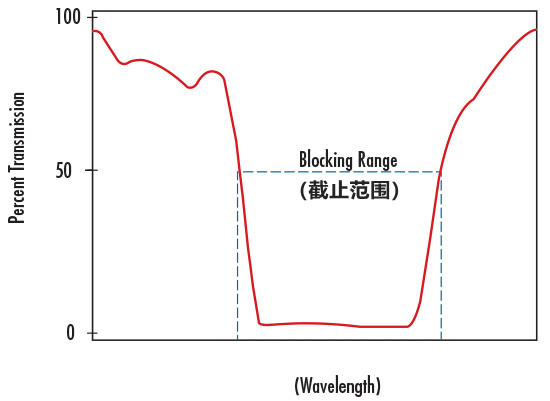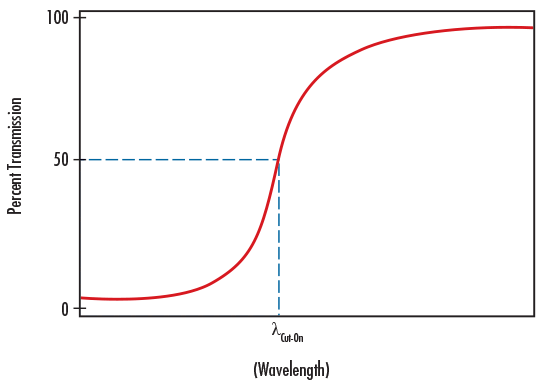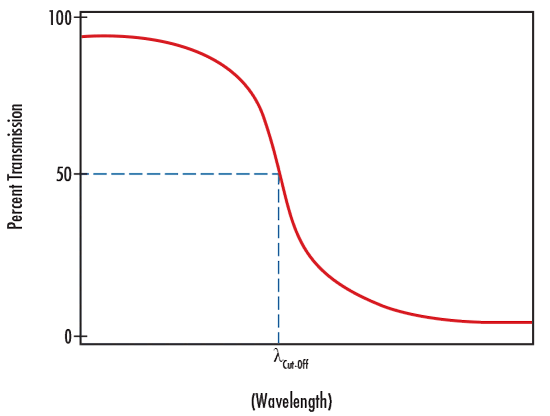Cutoff Range: The cutoff range is the wavelength interval used to indicate the region of the energy spectrum that is attenuated through the filter. The degree of blocking is usually specified in the optical density.

Cut-off range illustration chart
Optical Density (OD): OD is an abbreviation for optical density, which is the absorption of light as it passes through a sample.OD indicates that the optical density describes the amount of energy that is blocked or rejected by a filter, and is a term used in detection methods.The unit of detection is expressed as the OD value, OD=lg(1/trans), where trans is the transmittance of the test object.Higher optical density values indicate lower transmission. High OD values indicate low transmittance, while low OD indicates high transmittance. 6.0 or greater OD is used for extreme blocking needs, such as Raman spectroscopy or fluorescence microscopy. 3.0-4.0 OD is ideal for laser separation and purification, machine vision, and chemical detection, while 2.0 or less OD is ideal for color sequencing and separating spectral orders.
OD* indicates the cutoff, according to OD1~OD6, the transmittance of cutoff band is from 0.1~0.000001.
OD No. Cutoff Band Transmittance
OD1 = 0.1 i.e. 10%
OD2 = 0.01 i.e. 1%
OD3 = 0.001 i.e. 0.1%
OD4 = 0.0001 i.e. 0.01%
OD5 = 0.00001 i.e. 0.001%
OD6 = 0.000001 i.e. 0.0001%
Cutoff number Cutoff band
A 400~1100nm
B 300~1200nm
C 200~2000nm
D 400~700nm
E 400~800nm
F 400~1000nm
G 300~900nm
H 500~1000nm
I 800~1000nm
J 700~1200nm
K 200~1100nm
L 200~1200nm
M 200~1400nm
N 400~1200nm
O 200~1150nm
P 200~800nm
Q 350~700nm
U 200~700nm
V 300~950nm
W 200~1000nm
X 200~750nm
Examples:
OD3-A: Transmittance of light waves within the cutoff range of 400~1100nm is 0.001, except for 1/2 bandwidth on each side of the center wavelength.
OD3-B: The transmittance of light waves within the cut-off range of 300~1200nm is 0.001, except for the bandwidth of 1/2 bandwidth on each side of the center wavelength.
OD3-C: The transmittance of light waves within the cut-off range of 200~2000nm is 0.001, except for the bandwidth of 1/2 bandwidth on each side of the center wavelength.
OD3-D: The transmittance of light waves within the cut-off range of 400~700nm is 0.001, except for the bandwidth of 1/2 bandwidth on each side of the center wavelength.
OD3-K: The transmittance of light waves within the cut-off range of 200~1100nm is 0.001, except for the bandwidth of 1/2 bandwidth on each side of the center wavelength.
OD4-A: Transmittance of light waves within the cutoff range of 400~1100nm is 0.0001, except for 1/2 bandwidth on each side of the center wavelength.
OD4-B: Transmittance of light waves within the cutoff range of 300~1200nm is 0.0001, except for 1/2 bandwidth on each side of the center wavelength.
OD4-C: The transmittance of light waves within the cut-off range of 200~2000nm is 0.0001, except for the bandwidth of 1/2 bandwidth on each side of the center wavelength.
OD4-D: The transmittance of light waves within the cut-off range of 400~700nm is 0.0001, except for the bandwidth of 1/2 bandwidth on each side of the center wavelength.
OD4-K: The transmittance of light waves within the cut-off range of 200~1100nm is 0.0001, except for the bandwidth of 1/2 bandwidth on each side of the center wavelength.

Illustrative diagram of optical density
Starting wavelength is the term used to denote the wavelength at which the transmittance increases to 50% in the filter. The starting wavelength is given by λ in the following figurecut-onStarting representation.

Starting Wavelength Illustration Chart
Cutoff wavelength is a term used to indicate the wavelength at which the transmittance decays to 50% in the filter. The cutoff wavelength is given by λ in the following figurecut-offThe cutoff indicated.

Cutoff wavelength illustration
